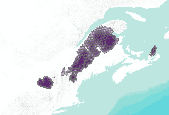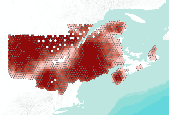Filters: Tags: population model (X)
44 results (68ms)|
Filters
Contacts
(Less)
|

This dataset depicts Wolf (Canis lupus) habitat in the Northern Appalachians predicted using the spatially explicit population model PATCH under the current habitat effectiveness plus low US mortality plus moderate Canadian mortality scenario (Carroll 2003). This dataset represents one of several scenarios testing the effects of habitat effectiveness and mortality rates on wolf populations. Static habitat suitability models for wolf were fed through PATCH to predict source and sink habitat areas across the landscape. The static models for wolf were created based on current and projected habitat effectiveness, which were based in part on road density and human population density. Wolf fecundity rates were based on...

This dataset depicts Wolf (Canis lupus) habitat in the Northern Appalachians predicted using the spatially explicit population model PATCH under the projected habitat effectiveness for 2025 plus moderate US mortality plus low Canadian mortality scenario (Carroll 2003). This dataset represents one of several scenarios testing the effects of habitat effectiveness and mortality rates on wolf populations. Static habitat suitability models for wolf were fed through PATCH to predict source and sink habitat areas across the landscape. The static models for wolf were created based on current and projected habitat effectiveness, which were based in part on road density and human population density. Wolf fecundity rates were...

This dataset depicts Marten (Martes americana) habitat in the Northern Appalachians predicted using the spatially explicit population model PATCH under the increased trapping intensity scenario (B4; Carrol 2007). This dataset represents one of several scenarios testing the interacting effects of trapping, timber harvest, habitat restoration, and climate change on marten populations. Static habitat suitability models for marten were fed through PATCH to predict source and sink habitat areas across the landscape. The static models for marten were created based on annual snowfall and percentage of older conifer and mixed forest. Demographic parameters were obtained from the literature and from calibration of the model....

This dataset depicts Lynx (Lynx canadensis) habitat in the Northern Appalachians predicted using the spatially explicit population model PATCH under the population cycling across the region plus trapping plus climate change scenario (FC2; Carrol 2007). This dataset represents one of several scenarios testing the interacting effects of population cycling, trapping, territory size, and climate change on lynx populations. Static habitat suitability models for lynx were fed through PATCH to predict source and sink habitat areas across the landscape. The static models for lynx were created based on a logistic regression model of reported lynx locations against the proportion of the landscape in deciduous forest cover...

This dataset depicts Wolf (Canis lupus) habitat in the Northern Appalachians predicted using the spatially explicit population model PATCH under the current habitat effectiveness plus high US mortality plus moderate Canadian mortality scenario (Carroll 2003). This dataset represents one of several scenarios testing the effects of habitat effectiveness and mortality rates on wolf populations. Static habitat suitability models for wolf were fed through PATCH to predict source and sink habitat areas across the landscape. The static models for wolf were created based on current and projected habitat effectiveness, which were based in part on road density and human population density. Wolf fecundity rates were based...

This dataset depicts Lynx (Lynx canadensis) habitat in the Northern Appalachians predicted using the spatially explicit population model PATCH under the population cycling only in Gaspe (core area) plus trapping scenario (B2; Carroll 2007). This dataset represents one of several scenarios testing the interacting effects of population cycling, trapping, territory size, and climate change on lynx populations. Static habitat suitability models for lynx were fed through PATCH to predict source and sink habitat areas across the landscape. The static models for lynx were created based on a logistic regression model of reported lynx locations against the proportion of the landscape in deciduous forest cover and annual...

This dataset depicts Marten (Martes americana) habitat in the Northern Appalachians predicted using the spatially explicit population model PATCH under the increased trapping Area scenario (B3; Carrol 2007). This dataset represents one of several scenarios testing the interacting effects of trapping, timber harvest, habitat restoration, and climate change on marten populations. Static habitat suitability models for marten were fed through PATCH to predict source and sink habitat areas across the landscape. The static models for marten were created based on annual snowfall and percentage of older conifer and mixed forest. Demographic parameters were obtained from the literature and from calibration of the model....

This dataset depicts Lynx (Lynx canadensis) habitat in the Northern Appalachians predicted using the spatially explicit population model PATCH under the population cycling only in Gaspe (core area) plus 36 square kilometer territory size (compared to 90 square kilometer territory) scenario (B136; Carroll 2007). This dataset represents one of several scenarios testing the interacting effects of population cycling, trapping, territory size, and climate change on lynx populations. Static habitat suitability models for lynx were fed through PATCH to predict source and sink habitat areas across the landscape. The static models for lynx were created based on a logistic regression model of reported lynx locations against...

This dataset depicts Marten (Martes americana) habitat in the Northern Appalachians predicted using the spatially explicit population model PATCH under the increased trapping area plus timber harvest scenario (L3; Carrol 2007). This dataset represents one of several scenarios testing the interacting effects of trapping, timber harvest, habitat restoration, and climate change on marten populations. Static habitat suitability models for marten were fed through PATCH to predict source and sink habitat areas across the landscape. The static models for marten were created based on annual snowfall and percentage of older conifer and mixed forest. Demographic parameters were obtained from the literature and from calibration...
This project integrates fire risk models, species distribution models (SDMs) and population models with scenarios of future climate and land cover to project how the effects of climate-induced changes to species distributions and land use change will impact threatened species in fire-prone ecosystems. This project also identifies and prioritizes potential management responses to climate change (e.g. assisted colonization, fire management, land protection, dispersal corridors). Anticipated products include: 1) maps (digital and hard copy) of habitat suitability under current and future climate change, current and future projected urban growth and combinations of climate change and future projected urban growth, under...
Categories: Data,
Project;
Tags: 2011,
Academics & scientific researchers,
CA,
CA-Southern,
California Landscape Conservation Cooperative,

This dataset depicts Marten (Martes americana) habitat in the Northern Appalachians predicted using the spatially explicit population model PATCH under the increased trapping intensity plus climate change scenario (FB4; Carrol 2007). This dataset represents one of several scenarios testing the interacting effects of trapping, timber harvest, habitat restoration, and climate change on marten populations. Static habitat suitability models for marten were fed through PATCH to predict source and sink habitat areas across the landscape. The static models for marten were created based on annual snowfall and percentage of older conifer and mixed forest. Demographic parameters were obtained from the literature and from...

This dataset depicts Marten (Martes americana) habitat in the Northern Appalachians predicted using the spatially explicit population model PATCH under the increased trapping intensity plus timber harvest scenario (L4; Carrol 2007). This dataset represents one of several scenarios testing the interacting effects of trapping, timber harvest, habitat restoration, and climate change on marten populations. Static habitat suitability models for marten were fed through PATCH to predict source and sink habitat areas across the landscape. The static models for marten were created based on annual snowfall and percentage of older conifer and mixed forest. Demographic parameters were obtained from the literature and from calibration...

This dataset depicts Marten (Martes americana) habitat in the Northern Appalachians predicted using the spatially explicit population model PATCH under the increased survival in parks scenario (B1; Carrol 2007). This dataset represents one of several scenarios testing the interacting effects of trapping, timber harvest, habitat restoration, and climate change on marten populations. Static habitat suitability models for marten were fed through PATCH to predict source and sink habitat areas across the landscape. The static models for marten were created based on annual snowfall and percentage of older conifer and mixed forest. Demographic parameters were obtained from the literature and from calibration of the model....

This dataset depicts Lynx (Lynx canadensis) habitat in the Northern Appalachians predicted using the spatially explicit population model PATCH under the no population cycling plus trapping plus 36 square kilometer territory size (compared to 90 square kilometer territory) scenario (A236; Carroll 2007). This dataset represents one of several scenarios testing the interacting effects of population cycling, trapping, territory size, and climate change on lynx populations. Static habitat suitability models for lynx were fed through PATCH to predict source and sink habitat areas across the landscape. The static models for lynx were created based on a logistic regression model of reported lynx locations against the proportion...
1.Wind farms are emerging as a major cause of mortality of large scavenging bird species, which may be catastrophic when they operate in concert with other threats. As a study model, we examine the impact of wind turbines on the population dynamics of a soaring bird species, when acting in conjunction with a sudden decrease in food availability following the European bovine spongiform encephalopathy (BSE) epidemic. 2.In Spain, vultures have been provided with supplementary food at traditional vulture restaurants for centuries. In 2006/2007, these feeding stations were closed as part of disease control measures. At the same time, wind farms were deployed within the vulture foraging range. We used capture–recapture...
Categories: Publication;
Types: Citation;
Tags: Gyps fulvus,
bovine spongiform encephalopathy,
mortality,
population model,
rescue effect,
Conserving migratory or wide-ranging species presents considerable challenges, as these individuals move across disparate jurisdictions often crossing international borders among crucial stages of their annual cycle. Within North America, Migratory Bird Joint Ventures (JVs) have established successful partnerships to coordinate the planning and delivery of conservation actions within key regions to benefit migratory bird populations. However, the extent to which local conservation actions influence regional demographics and in turn affect continental population dynamics remains poorly understood. Maximizing efficient use of limited resources to conserve habitats for wide-ranging species has motivated a critical...
Categories: Data;
Tags: ANIMALS/VERTEBRATES,
Academics & scientific researchers,
BIOLOGICAL CLASSIFICATION,
BIRDS,
Conservation NGOs,

This dataset depicts Wolf (Canis lupus) habitat in the Northern Appalachians predicted using the spatially explicit population model PATCH under the projected habitat effectiveness for 2025 plus low US mortality plus moderate Canadian mortality scenario (Carroll 2003). This dataset represents one of several scenarios testing the effects of habitat effectiveness and mortality rates on wolf populations. Static habitat suitability models for wolf were fed through PATCH to predict source and sink habitat areas across the landscape. The static models for wolf were created based on current and projected habitat effectiveness, which were based in part on road density and human population density. Wolf fecundity rates were...

This dataset depicts Wolf (Canis lupus) habitat in the Northern Appalachians predicted using the spatially explicit population model PATCH under the projected habitat effectiveness for 2025 plus moderate US mortality plus high Canadian mortality scenario (Carroll 2003). This dataset represents one of several scenarios testing the effects of habitat effectiveness and mortality rates on wolf populations. Static habitat suitability models for wolf were fed through PATCH to predict source and sink habitat areas across the landscape. The static models for wolf were created based on current and projected habitat effectiveness, which were based in part on road density and human population density. Wolf fecundity rates...

This dataset depicts Marten (Martes americana) habitat in the Northern Appalachians predicted using the spatially explicit population model PATCH under the increased survival in parks plus timber harvest scenario (L1; Carrol 2007). This dataset represents one of several scenarios testing the interacting effects of trapping, timber harvest, habitat restoration, and climate change on marten populations. Static habitat suitability models for marten were fed through PATCH to predict source and sink habitat areas across the landscape. The static models for marten were created based on annual snowfall and percentage of older conifer and mixed forest. Demographic parameters were obtained from the literature and from calibration...

This dataset depicts Marten (Martes americana) habitat in the Northern Appalachians predicted using the spatially explicit population model PATCH under the current trapping rates plus forest restoration plus climate change scenario (FR2; Carrol 2007). This dataset represents one of several scenarios testing the interacting effects of trapping, timber harvest, habitat restoration, and climate change on marten populations. Static habitat suitability models for marten were fed through PATCH to predict source and sink habitat areas across the landscape. The static models for marten were created based on annual snowfall and percentage of older conifer and mixed forest. Demographic parameters were obtained from the literature...
|

|